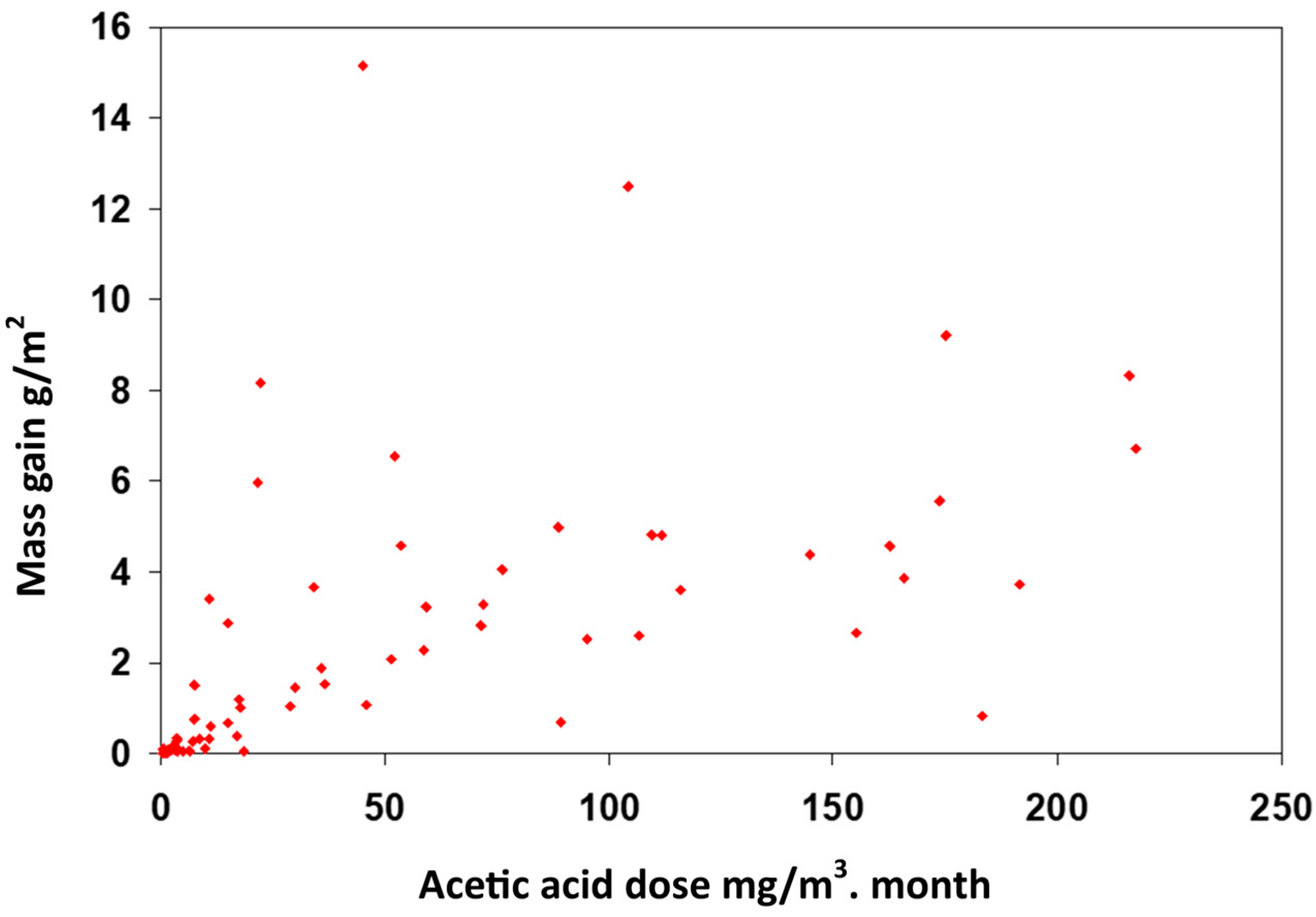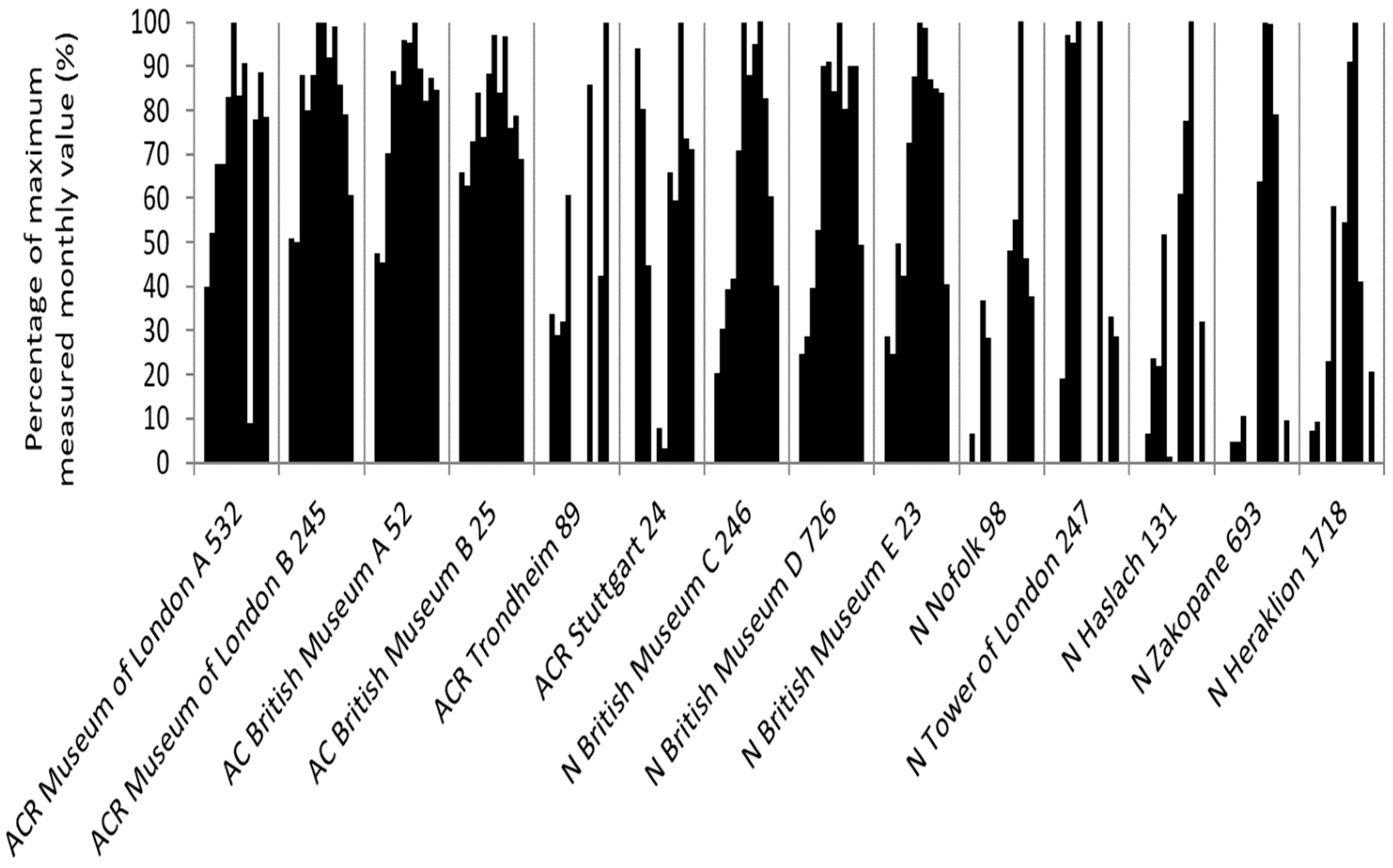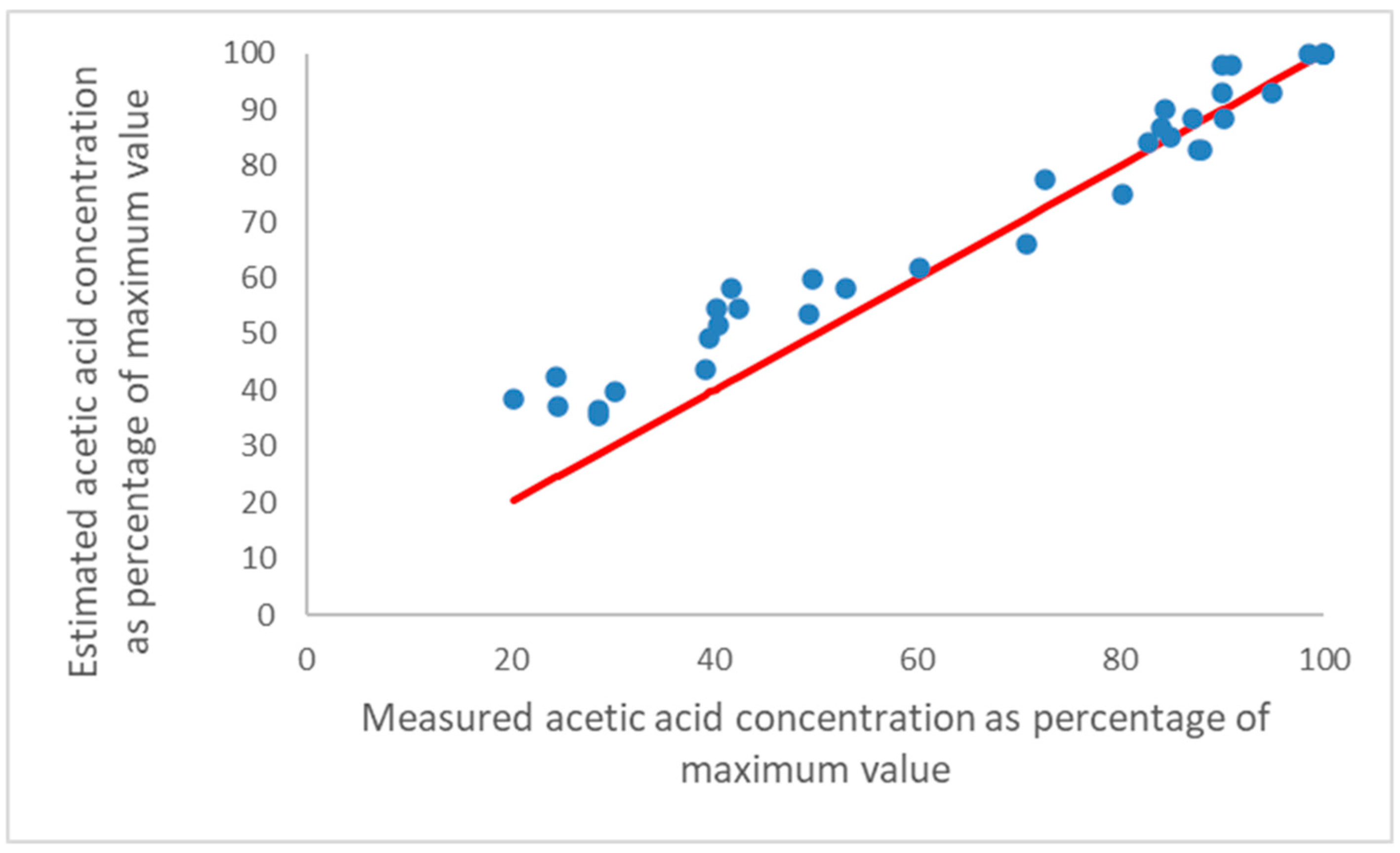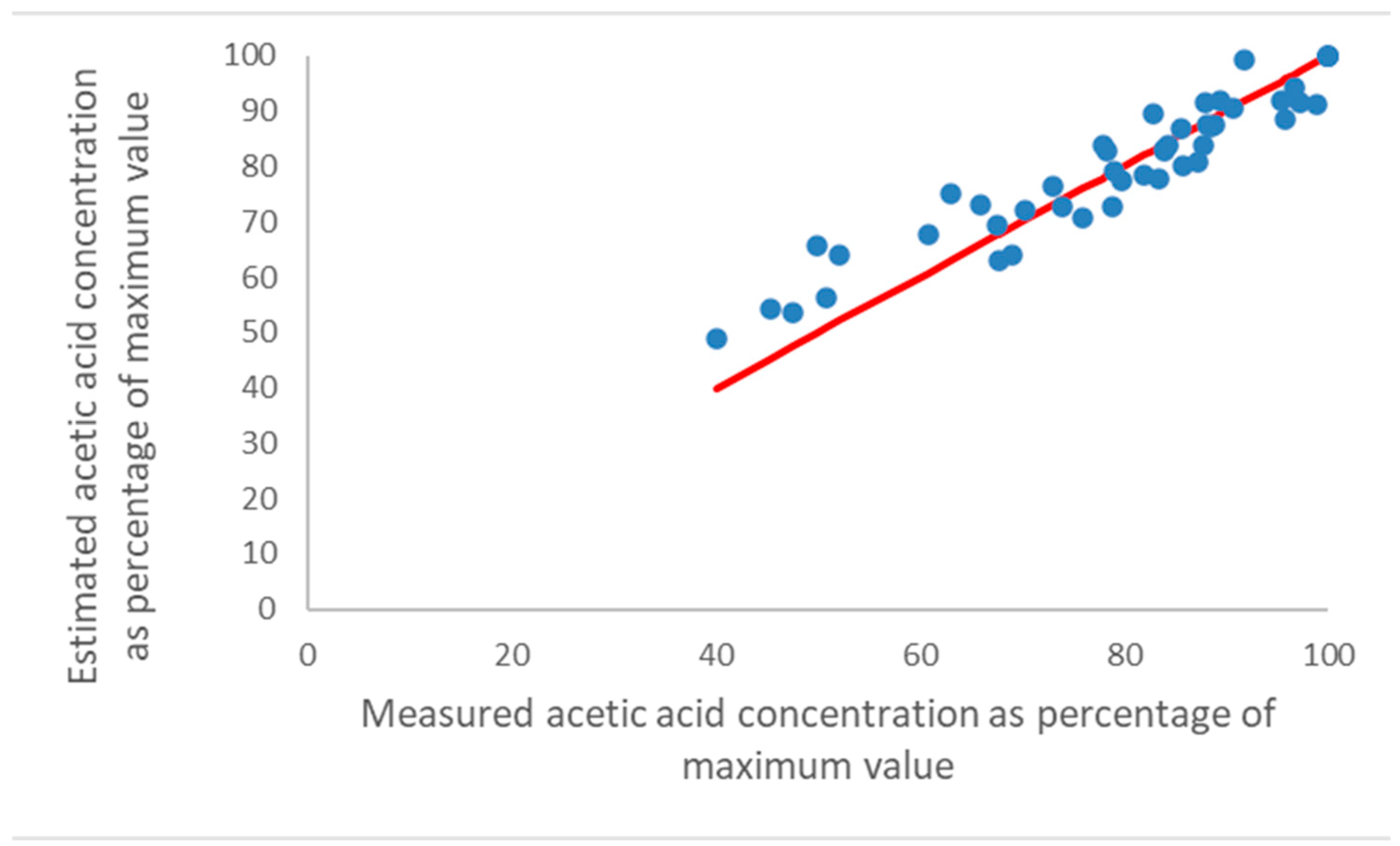Review of Interpreting Gaseous Pollution Data Regarding Heritage Objects
Abstract
:1. Introduction
- Research results. These have recently been described and the gaps in knowledge have been highlighted [2]. The collation of the research literature indicated that acetic and formic acid were implicated as the cause of over 65% of the reported instances of deterioration. Whilst a very small number of instances of concerning acetic and formic acid concentrations were reported in open rooms, the vast majority of issues were in stores, showcases and other enclosures. These can be considered as internally generated pollutants. Nitrogen dioxide and ozone have frequently been reported to cause damage but rarely with any numbers of affected objects reported, and so a percentage could not be calculated. These mainly originate externally. Hydrogen sulphide was attributed as the cause of damage in a further 15% of reported instances. This can originate both internally and externally. The results were collated into an assessment scheme in the MEMORI project. This has been expanded upon and will be outlined. Sulphur dioxide gas is known to be very corrosive, but its outdoor concentrations have been much reduced in Europe since the 1980s [3] and its indoor presence in museums is mostly very low [4]. More than twenty-five other gases have been reported to cause deterioration in museums [2], but the number of artefacts reported to be affected is much lower.
- Standards. Whilst many fields rely on standards to aid in pollution control, those produced for cultural heritage often give different values and their basis is frequently unclear. The standards are reviewed.
- Damage functions. Damage functions are mathematical relationships describing a change in property in relation to environmental parameters, including pollutant gas concentrations. A small number have been proposed for cultural heritage materials and even fewer have been suggested for indoor conditions.
2. Evaluation of Research Results of Pollution Gas Levels and Effects on Materials
3. Standards of Air Pollution Limits and Effects
4. Damage Functions
- Ag is the silver tarnish rate in Å (0.1 nm) per 30 days;
- H2S is the hydrogen sulphide concentration in ppb;
- NO2 is the nitrogen dioxide concentration in ppb;
- SO2 is the sulphur dioxide concentration in ppb;
- HCl is the hydrogen chloride concentration in ppb;
- O3 is the ozone concentration in ppb;
- RH is the mean RH, %;
- T is the mean temperature, °C.
5. Concentration or Dose, and Synergism with RH
6. Temporal Variations in Acetic and Formic Acid Concentrations in Showcases
7. Development and Testing of an Equilibrium Acetic Acid Concentration Tool
8. Conclusions
Author Contributions
Funding
Data Availability Statement
Conflicts of Interest
References
- Spiegel, E. (Care for Art, Koln, Germany). 2012 The Current Situation and Management of Indoor Air Pollution (IAQ) in European Collections, 2012. Unpublished manuscript.
- Thickett, D. Review of analysis for cultural heritage conservation. Curr. Top. Anal. Chem. 2020, 12, 73–88. [Google Scholar]
- Tidblad, J.; Kreislová, K.; Faller, M.; De la Fuente, D.; Yates, T.; Verney-Carron, A.; Grøntoft, T.; Gordon A Hans, U. ICP Materials Trends in Corrosion, Soiling and Air Pollution (1987–2014). Materials 2017, 10, 969. [Google Scholar] [CrossRef] [PubMed]
- Dahlin, E. (Ed.) EU Project MASTER. Final Report “Preventive Conservation Strategies for Protection of Organic Objects in Museums, Historic Buildings and Archives”; NILU OR 76/2010; NILU: Kjeller, Norway, 2010; Available online: https://projects.nilu.no/master/76-2010-emd-teg-MASTER.pdf (accessed on 9 August 2023).
- Tétreault, J. Airborne Pollutants in Museums Galleries and Archives; Canadian Conservation Institute: Ottawa, Canada, 2003.
- Grzywacz, C.M. Monitoring for Gaseous Pollutants in Museum Environments; Tools for Conservation; Getty Conservation Institute: Los Angeles, CA, USA, 2006; Available online: http://hdl.handle.net/10020/gci_pubs/monitoring_gaseous (accessed on 2 September 2023).
- ISO 16000-1:2004; Indoor Air—Part 1: General Aspects of Sampling Strategy. International Standards Organisation: Geneva, Switzerland, 2004.
- Gibson, L.T.; Watt, C.M. Acetic and formic acids emitted from wood samples and their effect on selected materials in museum environments. Corros. Sci. 2010, 52, 172–178. [Google Scholar] [CrossRef]
- Indoor Air Pollution Working Group. Available online: http:/iaq.dk/iap (accessed on 31 August 2023).
- Robinet, L. The Role of Organic Pollutants in the Alteration of Soda Silicate Glasses. Ph.D. Dissertation, University of Edinburgh, Edinburgh, UK, University of Paris VI, Paris, France, 2006. [Google Scholar]
- Tétreault, J.; Sirois, J.; Stamatopoulou, E. Study of lead corrosion in acetic acid environment. Stud. Conserv. 1998, 43, 17–32. [Google Scholar]
- Thickett, D.; Chisholm, R.; Lankester, P. Reactivity Monitoring of Atmospheres. In Metal 2013, Proceedings of the Interim Meeting of the ICOM-CC Metal Working Group, Edinburgh, Scotland, UK, 16–20 September 2013; Mardikian, P., Ed.; Historic Scotland and International Council of Museums: Edinburgh, UK, 2013; pp. 129–136. ISBN 978-92-9012-410-8. [Google Scholar]
- Wexler, A.; Hasegawa, S. Relative Humidity-Temperature Relationships of Some Saturated Salt Solutions in the Temperature Range 0° to 50 °C. J. Res. Natl. Bur. Stand. 1954, 53, 19–26. [Google Scholar] [CrossRef]
- Dahlin, E. (Ed.) EU Project POPAINT. Final Report. “Improved Protection of Paintings during Exhibition, Storage and Transit”; NILU OR 42/2010; NILU: Kjeller, Norway, 2010; Available online: http://propaint.nilu.no/ (accessed on 29 June 2023).
- Grøntoft, T.; Odlyha, M.; Mottner, P.; Dahlin, E.; Lopez-Aparicio, S.; Jakiela, S.; Scharff, M.; Andrade, G.; Obarzanowski, M.; Ryhl-Svendsen, M.; et al. Pollution monitoring by dosimetry and passive diffusion sampling for evaluation of environmental conditions for paintings in microclimate frames. J. Cult. Herit. 2010, 11, 411–419. [Google Scholar] [CrossRef]
- MEMORI. The MEMORI Technology. Innovation for Conservation. 2023. Available online: http://memori.nilu.no (accessed on 29 June 2023).
- English Heritage. Management of Showcases. Available online: https://www.english-heritage.org.uk/learn/conservation/collections-advice-and-guidance/ (accessed on 10 July 2023).
- BS 5454:1977; Recommendations for the Storage and Exhibition of Archival Documents. British Standards Institution: London, UK, 1977.
- Thomson, G. The Museum Environment; Butterworths: London, UK, 1978. [Google Scholar]
- NBSUR 83-2795; Air Quality Criteria for Storage of Paper Based Archival Records. National Bureau of Standards: Gaithersburg, MA, USA, 1983.
- National Research Council. Preservation of Historical Records; National Research Council: Washington, DC, USA, 1986; p. 29.
- BS 5454:1989; Recommendations for the Storage and Exhibition of Archival Documents. British Standards Institution: London, UK, 1989.
- BS 5454:2000; Recommendations for the Storage and Exhibition of Archival Documents. British Standards Institution: London, UK, 2000.
- NISO TR01; Environmental Guidelines for the Storage of Paper Records. National Information Standards Organization Press: Bethesda, MA, USA, 1995.
- Boston, G. Safeguarding the Documentary Heritage: A Guide to Standards, Recommended Practices, and Reference Literature Related to the Preservation of Documents of All Kinds; UNESCO: Milton Keynes, UK, 1998; pp. 19–20. [Google Scholar]
- NARA 1571; Archival Storage Standards. National Archives and Records Administration: Washington, DC, USA, 2002; p. 15.
- PD 5454; Guide for the Storage and Exhibition of Archival Materials. British Standards Institution: London, UK, 2012.
- PAS 198; Guide for the Specification for Managing Environmental Conditions for Cultural Collections. British Standards Institution: London, UK, 2012.
- American Society of Heating, Refrigerating and Air-Conditioning Engineers. Chapter 21 Museums, Galleries, Archives and Libraries. In 2003 ASHRAE Handbook: Heating, Ventilating, and Air-Conditioning Applications; Owen, M.S., Ed.; ASHRAE: Atlanta, GA, USA, 2003; pp. 21.1–24.46. [Google Scholar]
- American Society of Heating, Refrigerating and Air-Conditioning Engineers. Chapter 21 Museums, Galleries, Archives and Libraries. In 2007 ASHRAE Handbook: Heating, Ventilating, and Air-Conditioning Applications; Owen, M.S., Ed.; ASHRAE: Atlanta, GA, USA, 2007; pp. 21.1–24.46. [Google Scholar]
- Baer, N.S.; Banks, P.N. Indoor air pollution: Effects on cultural and historic materials. Int. J. Mus. Manag. Curatorship 1985, 4, 9–20. [Google Scholar]
- ISO 9223-2012; Corrosion of Metals and Alloys—Corrosivity of Atmospheres, Classification, Determination and Estimation. International Standards Organisation: Geneva, Switzerland, 2012.
- ISO 11844-2:2005; Corrosion of Metals and Alloys—Classification of Low Corrosivity of Indoor Atmospheres—Part 2: Determination of Corrosion Attack in Indoor Atmospheres. International Standards Organisation: Geneva, Switzerland, 2005.
- Pastorelli, G.; Cao, S.; Kralj Cigi, I.; Cucci, C.; Elnaggar, A.; Strlič, M. Development of dose-response functions for historic paper degradation using exposure to natural conditions and multivariate regression. Polym. Degrad. Stab. 2019, 168, 108944. [Google Scholar] [CrossRef]
- Thickett, D.; Chisholm, R.; Lankester, P. Development of damage functions for copper, silver and enamels on copper. In Proceedings of the Climate for Collections, Standards and Uncertainties, Munich, Germany, 7–9 November 2012; Archetype: London, UK, 2012; pp. 325–335. [Google Scholar]
- Fenech, A. Lifetime of Colour Photographs in Mixed Archival Collections. Ph.D. Thesis, University College London, London, UK, 2011. Available online: https://discovery.ucl.ac.uk/id/eprint/1333217/ (accessed on 2 September 2023).
- Gibson, L.T.; Cooksey, B.G.; Littlejohn, D.; Tennent, N.H. Determination of acetic acid and formic acid in the museum environment by passive sampling. Anal. Chim. Acta 1997, 341, 11–19. [Google Scholar] [CrossRef]
- Grøntoft, T. Performance evaluation for museum enclosures. Measurement, modeling and mitigation of pollutant impact on objects in museum enclosures. E-Preserv. Sci. 2012, 9, 36–46. Available online: http://www.morana-rtd.com/e-preservationscience/2012/Grontof-26-06-2012.pdf (accessed on 9 August 2023).
- Grøntoft, T.; Henriksen, J.; Hansen, J.E.; Ofstad, T.; Dahlin, E.; Lazaridis, M.; Czop, J.; Sommer-Larssen, A.; Hallett, K.; Calnan, C.; et al. EU project MASTER (EVK4-CT-2002-00093). Project Deliverable no. D.3.1, WP 3. Sensor and Environmental Data from the Field Test Programme. Published Project Report by NILU-Norwegian Institute for Air Research, NILU OR 45/2009. Available online: https://www.nilu.no/publikasjon/24477/ (accessed on 2 September 2023).
- Thickett, D.; Bradley, S.M. Assessment of the risks to metal artifacts exposed by volatile carbonyl pollutants. In Metal 98, Proceedings of the International Conference on Metals Conservation, Draguignan, France, 27–29 May 1998; Mourey, W., James, L.R., Eds.; James & James: London, UK, 1998; pp. 260–264. [Google Scholar]





| Equivalent Acetic Acid Concentration | Equivalent Formic Acid Concentration | GSD Response | Lead 50% RH | Glass | Copper 75% RH | Lignin-Free Paper | ||
|---|---|---|---|---|---|---|---|---|
| Acetic | Formic | Acetic | Formic | |||||
| 0–400 | <20 | 0–1.9 | ||||||
| 20–100 | ||||||||
| 100–200 | ||||||||
| 400–750 | 200–375 | 1.9–2.7 | ||||||
| 750–1500 | 375–750 | 2.7–4.3 | ||||||
| 1500–3000 | 750–1500 | 4.3–7.5 | ||||||
| 3000–6000 | 1500–3000 | 7.5–13.1 | ||||||
| >6000 | >3000 | >13.1 | ||||||
| Gas/Particle Concentration (µg/m3) | BS5454 1977 [18] | Thomson 1978 [19] | Nat Bur Std 1983 NBS [20] | NRC 1986 NRC [21] | BS5454 1989 [22], 2000 [23] | NISO 1995 NISO [24] | UNESCO 1998 [25] | NARA 2002 [26] | PD5454 2012 [27] |
|---|---|---|---|---|---|---|---|---|---|
| Acetic acid | BCT | 10 | |||||||
| Formaldehyde | BCT | 5 | |||||||
| Formic acid | |||||||||
| Nitrogen dioxide | 10 | 5 | BCT | 10 | 19 | 1 | 5 | 10 | |
| Ozone | 2 | 25 | 2 | 20 | 2 | 4 | |||
| Reduced sulphides (H2S) | |||||||||
| Sulphur dioxide | 50 | 10 | 1 | 1 | 10 | 27 | 1 | 2.7 | 1 |
| Total suspended particle | 75 | 75 |
| PAS 198 [28] | ASHRAE 2003 [29] | ASHRAE 2007 [30] | ||||||
|---|---|---|---|---|---|---|---|---|
| Gas/Particle Concentration (µg/m3) | Historic Soda Silicate Glass | Shell, Eggs | Lead | 1 Year | 10 Years | 100 Years | General Collections | Sensitive Materials |
| Acetic acid | 1000 | 100 | 1000 | 100 | 100 | 224 | 5 | |
| Formaldehyde | 300 | 20 | 5 | |||||
| Formic acid | 500 | 500 | 78 | 5 | ||||
| Nitrogen dioxide | 10 | 1 | 0.1 | 1 | 0.1 | |||
| Ozone | 10 | 1 | 0.1 | 0.05 | 0.5 | |||
| Reduced sulphides (H2S) | 1 | 0.1 | 0.01 | 0.1 | 0.01 | |||
| Sulphur dioxide | 10 | 1 | 0.1 | 0.4 | 0.04 | |||
| Fine particles PM2.5 | 10 | 1 | 0.1 | 1 | 0.1 | |||
| Corrosion Rate (mg/m2/yr) | |||||
|---|---|---|---|---|---|
| Copper | Silver | Sulphur Dioxide (μg/m3) | Chloride | ||
| ISO 11844 IC1 | V low ind | ≤50 | ≤70 | ||
| ISO 11844 IC2 | Low ind | 50–200 | 170–670 | ||
| ISO 11844 IC3 | Med ind | 200–900 | 670–3000 | ||
| ISO 11844 IC4 | High ind | 900–2000 | 3000–6700 | ||
| ISO 11844 IC5 | V high ind | 2000–5000 | 6700–16,700 | ||
| ISO 9223 C1 | v.Low | ≤900 | |||
| ISO 9223 C2 | Low | 900–5000 | <5 | ||
| ISO 9223 C3 | Med | 5000–12,000 | 5–30 or | low | |
| H2S (ppb) | NO2 (ppb) | SO2 (ppb) | HCl (ppb) | O3 (ppb) | RH (%) | Temp (°C) | Silver Corrosion Rate (Å/30 Days) | ||
|---|---|---|---|---|---|---|---|---|---|
| Apsley House | May | 27.47 | 27.98 | 1.26 | 25.01 | 1.59 | 50.27 | 10.53 | 144.11 |
| June | 26.32 | 24.40 | 1.32 | 29.82 | 1.67 | 53.49 | 10.92 | 147.94 | |
| July | 25.53 | 30.81 | 1.56 | 11.06 | 1.45 | 57.55 | 11.86 | 139.82 | |
| August | 27.38 | 26.06 | 1.35 | 25.49 | 1.78 | 63.89 | 11.54 | 157.50 | |
| September | 0.57 | 18.7 | 0.3 | 4.5 | 7.9 | 53.5 | 12.5 | 142.76 | |
| Audley End House | May | 0.03 | 1.7 | 0.2 | 0.3 | 12.1 | 41.2 | 11.32 | 60.22 |
| June | 0.05 | 2.0 | 0.2 | 0.1 | 9.7 | 44.5 | 13.43 | 65.13 |
Disclaimer/Publisher’s Note: The statements, opinions and data contained in all publications are solely those of the individual author(s) and contributor(s) and not of MDPI and/or the editor(s). MDPI and/or the editor(s) disclaim responsibility for any injury to people or property resulting from any ideas, methods, instructions or products referred to in the content. |
© 2023 by the authors. Licensee MDPI, Basel, Switzerland. This article is an open access article distributed under the terms and conditions of the Creative Commons Attribution (CC BY) license (https://creativecommons.org/licenses/by/4.0/).
Share and Cite
Thickett, D.; Grøntoft, T. Review of Interpreting Gaseous Pollution Data Regarding Heritage Objects. Heritage 2023, 6, 6917-6930. https://doi.org/10.3390/heritage6100361
Thickett D, Grøntoft T. Review of Interpreting Gaseous Pollution Data Regarding Heritage Objects. Heritage. 2023; 6(10):6917-6930. https://doi.org/10.3390/heritage6100361
Chicago/Turabian StyleThickett, David, and Terje Grøntoft. 2023. "Review of Interpreting Gaseous Pollution Data Regarding Heritage Objects" Heritage 6, no. 10: 6917-6930. https://doi.org/10.3390/heritage6100361





